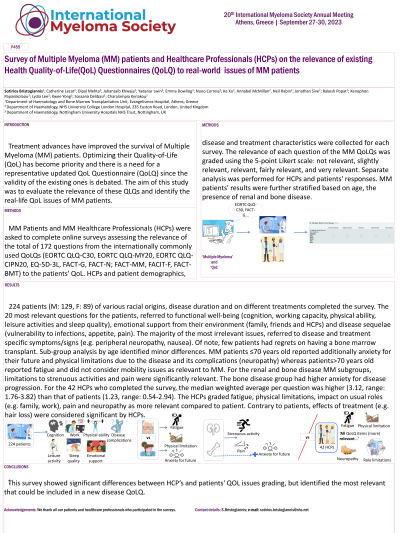QoL and Patient-Reported Outcome and Supportive Care
Poster Session 3
P-455: Survey of Multiple Myeloma (MM) patients and Healthcare Professionals (HCPs) on the relevance of existing Health Quality-of-Life (QoL) Questionnaires (QoLQ) to real-world QoL issues of MM patients
Friday, September 29, 2023
1:15 PM - 2:15 PM EEST


Sotirios Bristogiannis
Haematology Registrar
Evangelismos General Hospital, Athens, Greece
Athens, Attiki, Greece
Introduction: Treatment advances have improved the survival of MM patients. Optimizing QoL has become a priority and there is a need for a representative updated QoL Questionnaire (QoLQ) since the validity of the existing ones is debated. The aim of this study was to evaluate the relevance of these QLQs and identify the real-life QoL issues of MM patients.
Methods: MM patients and Healthcare professionals (HCPs) at University College London Hospital (UK) were asked to complete online surveys assessing the relevance of 172 questions from QoLQs that are commonly used for MM patients internationally (EORTC QLQ-C30, EORTC QLQ-MY20, EORTC QLQ-CIPN20, EQ-5D-3L, FACT-G, FACT-N; FACT-MM, FACIT-F, FACT-BMT) to patients' QoL. Demographics, disease and treatment characteristics were collected for each survey. The relevance of each question of the QoLQs was graded using the 5-point Likert scale: not relevant, slightly relevant, relevant, fairly relevant, and very relevant. HCPs’ and patients’ responses were analysed separately. MM patients' results were further stratified based on age, the presence of renal and bone disease.
Results: 224 patients (M: 129, F: 89) of various ethnicities, disease duration and treatment history completed the survey. The 20 most ‘relevant’ questions for patients were related to functional well-being (cognition, working capacity, physical ability, leisure activities and sleep quality), emotional support from their environment (family, friends and HCPs) and disease sequelae (vulnerability to infections, appetite, pain). The majority of the most irrelevant questions referred to disease and treatment specific symptoms/signs (e.g. peripheral neuropathy, nausea). Of note, few patients regretted having a bone marrow transplant. Sub-group analysis by age identified minor differences: patients ≤70 years old reported additionally anxiety for their future and physical limitations due to the disease and its complications (neuropathy) whereas patients>70 years reported fatigue and did not consider mobility issues as relevant to MM. For renal and bone disease subgroups, limitations to strenuous activities and pain were significantly relevant. The bone disease group had higher anxiety for disease progression. For the 42 surveyed HCPs, the median weighted average per question was higher (3.12, range: 1.76-3.82) than that of patients (1.23, range: 0.54-2.94). HCPs graded fatigue, physical limitations, impact on usual roles (e.g. family, work), pain and neuropathy as more relevant compared to patient. Contrary to patients, effects of treatment (e.g. hair loss) were considered significant by HCPs.
Conclusions: This survey highlighted significant differences between HCPs’ and patients' views of QoL issues. It identified the significant areas that we would advocate to be included in a new disease QoLQ.
Methods: MM patients and Healthcare professionals (HCPs) at University College London Hospital (UK) were asked to complete online surveys assessing the relevance of 172 questions from QoLQs that are commonly used for MM patients internationally (EORTC QLQ-C30, EORTC QLQ-MY20, EORTC QLQ-CIPN20, EQ-5D-3L, FACT-G, FACT-N; FACT-MM, FACIT-F, FACT-BMT) to patients' QoL. Demographics, disease and treatment characteristics were collected for each survey. The relevance of each question of the QoLQs was graded using the 5-point Likert scale: not relevant, slightly relevant, relevant, fairly relevant, and very relevant. HCPs’ and patients’ responses were analysed separately. MM patients' results were further stratified based on age, the presence of renal and bone disease.
Results: 224 patients (M: 129, F: 89) of various ethnicities, disease duration and treatment history completed the survey. The 20 most ‘relevant’ questions for patients were related to functional well-being (cognition, working capacity, physical ability, leisure activities and sleep quality), emotional support from their environment (family, friends and HCPs) and disease sequelae (vulnerability to infections, appetite, pain). The majority of the most irrelevant questions referred to disease and treatment specific symptoms/signs (e.g. peripheral neuropathy, nausea). Of note, few patients regretted having a bone marrow transplant. Sub-group analysis by age identified minor differences: patients ≤70 years old reported additionally anxiety for their future and physical limitations due to the disease and its complications (neuropathy) whereas patients>70 years reported fatigue and did not consider mobility issues as relevant to MM. For renal and bone disease subgroups, limitations to strenuous activities and pain were significantly relevant. The bone disease group had higher anxiety for disease progression. For the 42 surveyed HCPs, the median weighted average per question was higher (3.12, range: 1.76-3.82) than that of patients (1.23, range: 0.54-2.94). HCPs graded fatigue, physical limitations, impact on usual roles (e.g. family, work), pain and neuropathy as more relevant compared to patient. Contrary to patients, effects of treatment (e.g. hair loss) were considered significant by HCPs.
Conclusions: This survey highlighted significant differences between HCPs’ and patients' views of QoL issues. It identified the significant areas that we would advocate to be included in a new disease QoLQ.
